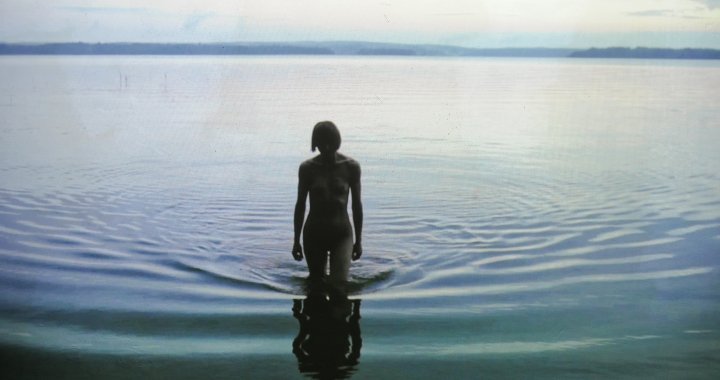
Distant Moods On a Blue Evening
An exhibition review
23/07/2015
Photo: Kristaps Kalns
“Distant Moods On a Blue Evening” is the romantic and multilayered title of this year's visual art exhibition at the Cēsis Art Festival, lasting from July 3 to August 9 at the Cēsis alus brūzis (Cēsis Beer Brewery). Inga Šteimane, curator of the exhibition, has invited 14 artists hailing from the Baltic and Nordic countries to speak about today's topical subjects through each artist's personal understanding of lines from the poetry and prose of Latvia's most famous author, Rainis.
The exhibition is notable, firstly, for being the largest exhibition ever of Nordic and Baltic artists to be held in Latvia. Secondly, the curator has succeeded in gathering together artists whose works have a powerful, and intellectual, heft to them.
Of course, the theme of the show – Distant moods on a blue evening. – is enticing. Most of the works were also specially created for the exhibition, although as Šteimane points out, “the exhibition has its own individual objectives, and it does not illustrate Rainis.” Overall, the show offers up a manifold reading of the world, with each artist revealing his or her very individual approach to viewing this world; nevertheless, most of the works are linked by a common thread – a heightened sensitivity to what is going on around us.
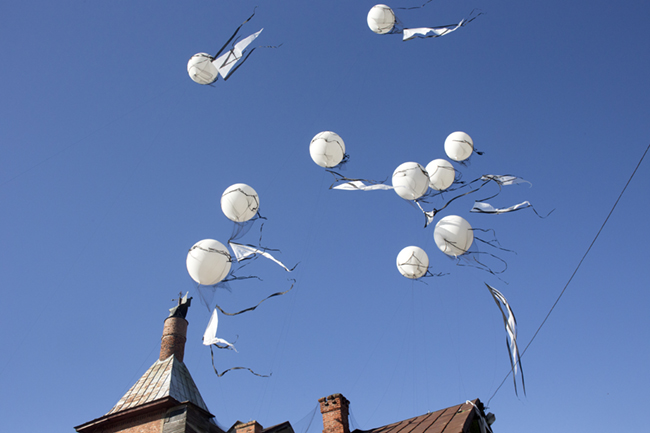
Arturs Virtmanis. “Augšāmcelšanās blūzs / Resurrection Blues”. 2015
On opening day, the exhibition's location can be discerned already from a distance; above the Cēsis Beer Brewery, helium balloons – melancholic “thought-clouds” – reach for the sky in the grandiose installation by Arturs Virtmanis, “Augšāmcelšanās blūzs / Resurrection Blues”. The balloon-strings and their attached flags tangle with one another, creating a self-contained conglomerate of strange shapes that, because of its fragile nature, slowly approaches its self-destruction: one after another, the balloons are inescapably torn apart by the wind – reminding us of the impermanence of everything. This depressingly dramatic feeling is intensified by the second part of Virtmanis' installation – the scythes in place of the clock hands on the tower of the brewery, which move at a quickened pace as they announce the accelerating speed of world destruction. It basically screams: “inevitability, the inability to reach a higher level or transience”; similar feelings overcome one when viewing the exhibited works of other artists.

Miķelis Fišers. “Kalnā kāpējs / Mountain climber”. 2015
For instance, Miķelis Fišers' audiovisual installation “Kalnā kāpējs / Mountain climber” – it removes any hope of a possible “happy end”. It is a play on one of Rainis' most popular poems: “...You will become more lonely year by year, Friend after friend will turn away from you...”; with this piece, Fišers takes us into the world of romanticized isolation and the suffering genius. The space he has created both formally and ideologically intensifies the theme indefinitely: an effective etching done in black lacquered wood (which, by the way, has been seen in other exhibitions not even that long ago) has been enlarged to mega-proportions and has thereby assumed a three-dimensional effect. The hero of the story has acquired four legs with which to make his journey up the mountain, to where he has only hardship and isolation waiting for him. He is ready to sacrifice the present in order to reach an unknown goal. Perplexing is Saulcerīte, another of Rainis' characters, flying in her coffin off into the distance; it seems that there is no chance of Fishers' hero awakening her. The overall atmosphere of the piece is made even more dense by the sounds created by the musician Error: at times the space is filled with blanketing ambient noise, at others – with sorrowful yodeling.

Thomas Behling. “Mountain”. 2010
Also entwined in melancholy seem to be the works on display by German artist Thomas Behling. Behling plays with the images and moods found in the works of the Old Masters by giving them new contexts and meanings. With the help of reproductions, photographs and objects found at thrift shops, Behling creates his own world by connecting various viewpoints and levels of perception. He speaks ironically about the prejudices and stereotypes that rule our lives. A world of dreams and fantasy, memories of events (perhaps) experienced that tempt one to return, but without any guarantee of safety because the floor has collapsed (“Room 6”) and the glass is broken (“Untitled”)...
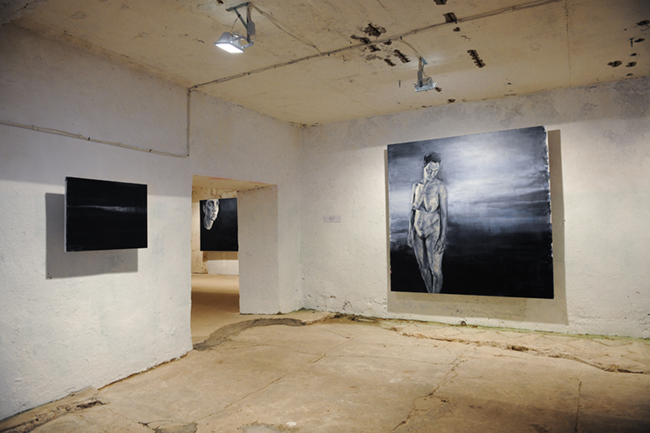
Paintings by Bolatta Silis-Høegh
A practically apocalyptic sensation is also emitted by the paintings of Bolatta Silis-Høegh, an artist living in Greenland and Denmark but with Latvian roots. Environmental and emotional elements rage in abstract landscapes and self-portraits, warning us of the globe's plummet into ecological catastrophe – fear, anger, inevitability and powerlessness. Saturated with dark paint, the expressive brushstrokes and lines contrast with the empty spaces of the canvas and create a mounting feeling of anxiety and unease, thereby revealing man's fragility and defenselessness.
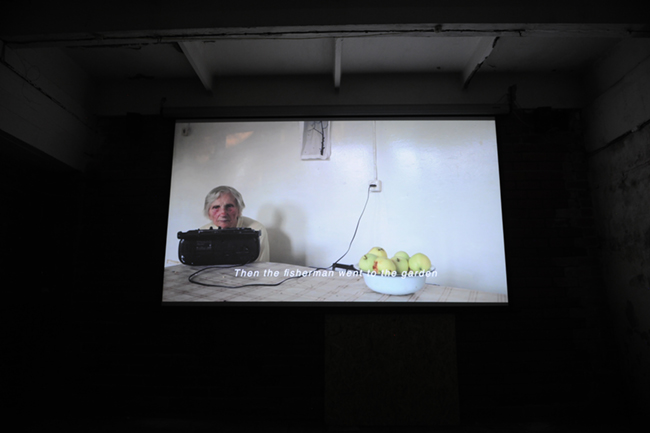
Emilija Škarnulytė. “Aldona”. 2012
In an adjacent room, the video work “Aldona”, by Lithuanian artist Emilija Škarnulytė, is on view. This personal video opens the door to several worlds – it is a study of the daily life of a person who has gone blind, as well as a journey into a land of phantoms from the past, all of which are sinking into oblivion. The film's main character, Škarnulytė's grandmother Aldona – who lost her sight as a result of the Chernobyl nuclear power plant catastrophe, leads us through a special place: Grūtas Park in Lithuania, a place where Soviet-era statues were taken and collected in the period following the country's regaining of independence. Having once stood on pedestals, they now live among the park's piles of leaves and stretches of moss and lawn. The masterful use of formal forms of expression allow one to truly enjoy not only a journey back into time, but also the aesthetic qualities of the video. The story's protagonist communicates with the granite witnesses of the past – she feels for and touches each groove that has been chiseled into the rock, and before our eyes, she relives memories of the time when humungous sculptures of Lenin and communist partisans decorated the central squares of every city in the soviet republics.

Jurga Barilaite. “Abracadabra”. 2014
References to issues of history and interpersonal communication can also be seen in the work by Lithuanian artist Jurga Barilaite, the four-channel installation “Abracadabra”. On one screen we see the artist as she tirelessly chants verses of magical spells. Using the languages of all of the peoples living in Lithuania – Lithuanians, Russians, Poles, Jews – she has created rhyming verses in a fabricated language and uses them as an expansive metaphor for Lithuanian history. Her piercingly captivating gaze and the rhythmic combinations of words make for a legitimately hypnotic effect.
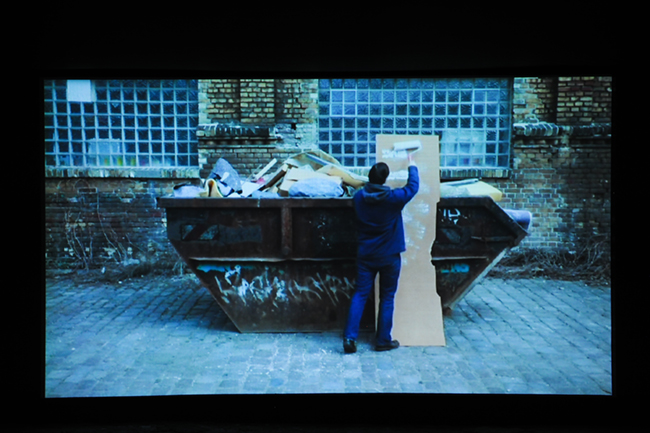
Sophia Hultén. “Altered Fates”. 2013
In her video works “Trucking” and “Altered Fates”, Berlin-based Swedish artist Sophia Hultén plays with possibilities and choices. By transferring rubbish from one pail to another, turning a plastic bag inside-out, and changing her shoes numerous times, Hultén both offers us a choice and changes the contents – whichever we choose, that will be our future. Is having a choice a burden, or is it better to just go with the flow – “It is what it is.”? Nevertheless, in the video work, by doing things with all of these household and industrial objects that she every so often picks out of a rubbish bin, Hultén doesn't get involved in discussions on searching for the meaning of life; instead, it is more of a documentation of an everyday situation and the realization of personal choice.

Sten Are Sandbeck. “mOther”
For the creation of his installations, Norwegian artist Sten Are Sandbeck uses driftwood, found objects and plastic bags. Bringing to mind the works of Alexander Calder, Sandbeck's two mobile-constructions speak both to the viewer and to one another in the most direct way possible – when moving through the space, one cannot help but touch one of them, thereby causing both installations to swing and spin as they subject the space to their inclinations. Titled “mOther” and “What You Want”, they are the fulfillment of each other's wishes; they are codependent. Sandbeck plops into the center of attention both this constantly mobile search for the fulfillment of one's wishes, and the need for balance, i.e., the modern-day perpetual demand for new allurements.

Work by Marike Estna
Just as clean in terms of form is the installation by Iceland's Margrét Blöndal. When entering the room, all we see are some ropes, a strangely shaped piece of rubber, and strips of a ripped cloth bag. Surprisingly, these small, seemingly useless things organize the room in the finest of ways, and fills it with a world of visions and feelings. Almost imperceptibly, they bring a story to the space. In contrast to Blöndal's discrete Northern unpretentiousness, in the next room there's an explosion of color, rhythm and texture in the floor painting “Untitled”, by London-based Estonian artist Marike Estna. Estna's piece is almost like a stage that literally asks one to step up on it and express one's opinion. The rhythm of brightly-hued brushstrokes submits itself to several layers of interpretation – on one hand, they remind one of the rhythms seen in music or calligraphy, in which every once in a while a sampling of some other piece “slips in”; on the other, they mimic the movements associated with the domestic activity of washing the floor. The consolidation of both of these layers creates an interesting visual pattern. Also playing an important part is the positioning of the artwork. Estna draws attention to a hierarchy – how the painting's role changes when it is on the floor; how the viewer perceives it, experiences it. She does not accept the self-sufficient nature of fine-art painting, and provokes the viewer into coming into contact with the piece and communicating with it. Direct communication with an artwork is also something that the Estonian artist Margus Tamm anticipates – his spacial installation “Raymond the Diamond” asks the viewer to “step into it”. Like a 1980s video game, the graphic labyrinth of black tubes tempts one to head down into the diamond mines. Monster guards have been replaced with small black piglets, and the video game feel is intensified by the playing of rhythmic electronic dance music composed by Marta Stratskas. Tamm gives the space structure and connects the different sections of the labyrinth, but the viewer must choose him- or herself which road to take.
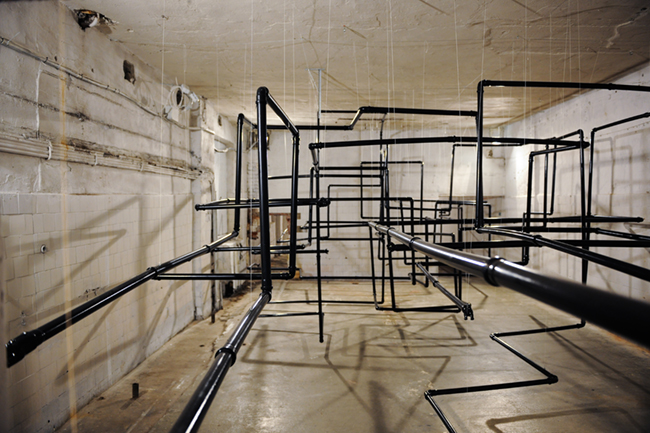
Margus Tamm. “Raymond the Diamond”. 2014
Finnish artist Elina Brotherus presents two idyllic-themed video works: “The Black Bay Sequence” and “My Happiness is Round”. Both are linked by a wave of existential contemplation that, if succumbed to, can take one to a completely different time and place.
Undoubtedly, this exhibition is a noteworthy event. Not only because of its international quality, but also because it cites a connection to an era in both an emotional and intellectual manner. Each artist's individual narrative and form of expression notwithstanding, the overall mood allows one to orient oneself within this manifold discourse and feel the breezes that drift down from the northern part of our globe.